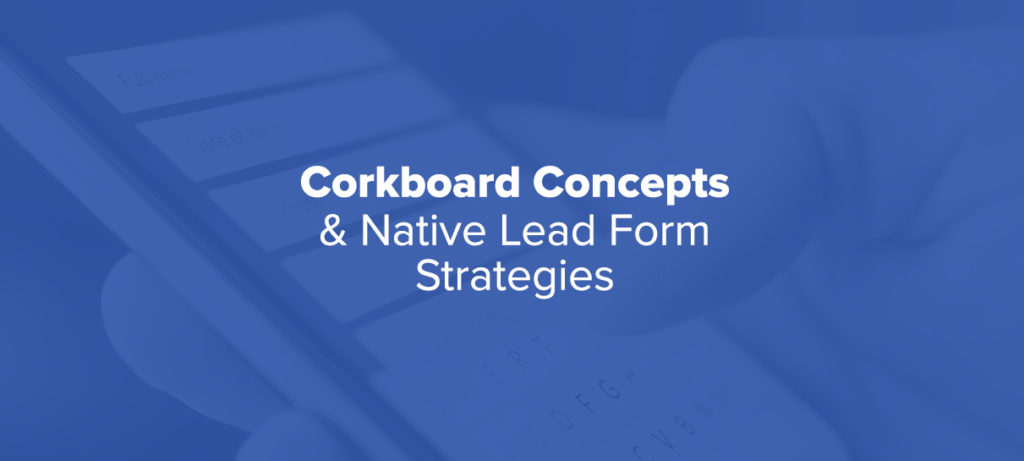Utilizing Native Lead Forms In Your Digital Marketing Strategy
Native lead forms have increased in popularity over the past couple of years and with the onset of IOS 14 elimination of Pixel Tracking, is poised to increase even more. A lot of large social media platforms have offered Native Lead Forms for years and even Snapchat is entering the Native Lead Form space. Google has made some changes to how their lead forms are as well.
What’s the difference between Native Lead Form campaigns and traditional lead form conversion campaigns?
Traditional lead form conversion campaigns happen on the advertisers website. The most simple way to look at this is that the end-user/prospect is on a website whether it be Facebook, LinkedIn, Google search, etc., sees and takes action on an ad (clicks), then is directed to the advertisers website where they fill out information on the form.
What are the benefits of Native Lead Form campaigns?
- Tracking is done in a single place. There is no need for third party cookies because the user converts on the platform, meaning they’ll just need first party pixels.
- Pre-filled information comes from the profile that is housed on the platform. Most users won’t have their information stored on the end-advertisers website, especially for SMB’s, but do on larger sites like Google and social media platforms.
- Keeping people where they’re comfortable. Most people on social media sites are loyal to social media platforms, not your company/website. Additionally, this eliminates the hand-off from one platform to another, taking out the problem of load times.
Corkboard Concepts Approach To Native Lead Form Campaigns
At Corkboard Concepts, we utilize Native Lead Form campaigns into a number of Automotive, Powersports, and other industries ad campaigns to help them generate new leads. Our team of specialists work to better understand the inputs (targeting), outputs (performance) and downstream ability to nurture the leads of these campaigns. Targeting can vary but one of the most beneficial items of Native Lead Form campaigns is the optimization.
Our initial approach generally focuses on quantity of lead forms over quality (don’t worry, high quality + high quantity is our goal, but we have to start somewhere!). One of the best ways to continue to enhance targeting though is by eventually refining the questions in the forms to further pre-validate leads.
As campaigns progress, the goal is to change from Quantity to Quality, while also increasing the number of questions or types of questions. The individual type of question can really change the outcome of the lead form fill, which when aligned with conversion optimization can really have a positive impact on campaign targeting!
Let’s explore some of the individual options for Native Lead Form ads that exist out there.
Facebook Native Lead Forms:
Facebook Native Lead Forms are some of the most popular lead forms that are out there and for many reasons.
- They’re easy to set up.
- They get a lot of engagement.
- They’re easy to extract user information from.
Due to all of the personal information stored on Facebook, some insights are automatically pulled through from the users profile. These include basics like name and location, as well as contact information like phone and email.
Facebook also makes it convenient to track leads through their version of a CRM, as well as integrating it into Facebook Messenger. In order to sync with email or CRM’s, Corkboard Concepts leverages a third-party software to make that connection.
LinkedIn Native Lead Form:
LinkedIn lead forms happen very similarly to that of Facebook. They’re connected with a post and allow for a business to more easily extract personal information on the lead form. LinkedIn is a very popular B2B platform and makes it easy to pull additional information like personal and work emails, phone numbers and more.
Like most things with LinkedIn advertising, it’s quite expensive. Be sure to have your audience well defined and compelling creative/offers are used to maximize your marketing expense.
Google Ads Native Lead Forms:
Google has long offered Native Lead Forms ads but they have recently gone through an overhaul. Google, likely keeping up with the expanded benefits of first-party tracking and native lead form generation, had changed their lead forms to add in more fields and to fast track common implementations.
Google Native Lead Form Ads are relatively simple to implement. They’re an Ad Extension and can work with Search, Display and Video campaigns.
Snapchat Native Lead Forms:
Snapchat Native Lead Forms are relatively new to the game. Up until 2021, Snapchat had just offered standard Lead Form optimization but with new pixel policies they’ve moved to the native form fill opportunities.
And, they’ve seen a huge uptick in lead generation from the Native Lead Forms vs. Website Form Fills.
Swipe Up conversions lead to about a 4x multiplier over traditional lead forms.
When taking a look at certain advertising, Snapchat may fit better into a client’s outreach tactics because of the audience, targeting, competition present (there are far fewer local advertisers currently on Snapchat than say Facebook/Instagram), and more.
Native Lead Forms In Your Marketing Strategy
Regardless of your marketing strategy, Native Lead Forms or email collection marketing is going to be increasingly important in your 2021 advertising strategy. Profile views attached to certain information, like an email address, are going to become very important in continuous targeting and also conversion reporting.
